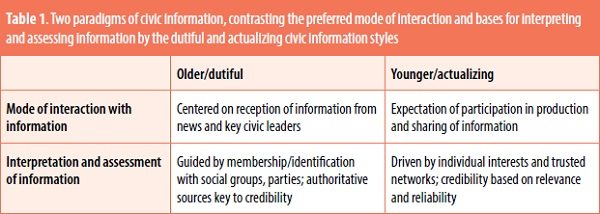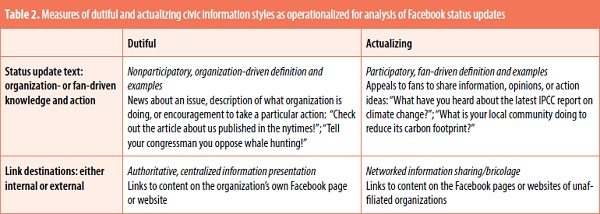
“CONSTELLATIONS” by Federico Cortese /www.federicocortese.com
Editors’ note: This article was adapted from a study published by New Media & Society, SAGE Publications (www.sagepub.co.uk), in June 2014 (vol. 16, no. 4). We thank NMS, SAGE, and the author for their kind permission. The author wishes to thank Tim Carlson, Cory Eng, Lily Ly, and Kiyomi Higutchi for assistance in coding, and W. Lance Bennett, Deen Freelon, Lew Friedland, and anonymous reviewers for their helpful suggestions on the manuscript. Research for the study was supported by a University of Washington Department of Communication Graduate Student Research Grant.
|
Questions that will be answered in this article
How you might want to make use of it
|
Since the mid-nineteenth century, particularly in the United States, civic institutions such as political parties, interest groups, government watchdogs, and community associations have provided essential connections between individual citizens and political processes. They have coordinated collective efforts, developed political resources, and offered strategic expertise in navigating complex political waters. They have also been conduits of civic information, producing newsletters and pamphlets describing issues and positions, hosting interpersonal meetings, and providing interpretation of information from journalists and other sources. Given these essential roles, it is hard to imagine the future of public engagement without such institutions. Over the course of the second half of the twentieth century, however, these institutions declined and their work changed.
A Paradigm Shift
A number of explanations have been offered for the decline,1 and while not contradicting any of these, the framework of civic information styles that this article advances adds a new perspective.
We argue that a paradigm shift in the logic and structure of the information system is underway, which may entail a period of disjuncture as institutions of democratic society lag behind (especially younger) individuals’ preferences and habits with respect to how they interact with civic information. The framework’s communication- centered view suggests that part of the disjuncture may be attributable to civic organizations’ adaptation to the “media politics” of the late twentieth century, in which their communications became driven by the need to compete in a highly competitive, mass-mediated political communication environment.2 Organizations’ needs for active member input were lowered, as they relied increasingly on experts to frame both policy and their public face, and the costs of member input were raised, as the risk of members’ actions or communications disrupting the carefully honed message of the communication officials increased.
This falls in line with Theda Skocpol’s analysis of participation in civic organizations, in which she notes a shift in organizations’ structures from “membership”’ organizations rooted in small, personal gatherings to “management” conglomerates aggregating the resources—often simply financial—of disparate individuals into a strategically directed political force.3 These management organizations offer a citizen–communication relationship increasingly in conflict with the participatory preferences that have been developing over the past several decades, and the rapid dispersion of digital communication technologies in the last decade, in particular, has spurred scholarly interest in how changes in communication technology might be reshaping—and possibly reinvigorating—citizens’ opportunities and inclinations for engagement. In addition, research has especially focused on the engagement of young citizens, a population historically underengaged and among the most active users of digital media.4
This article, too, concentrates on young people and engagement; however, unlike much recent work on digital media and civic engagement, it does not cover the myriad ways in which digital media enable novel forms of decentralized and personalized social movements or activities. As exciting as these new forms of political communication are, this study makes the case that it would be a mistake to neglect how digital media are transforming the relationship between citizens and the major civic organizations that have guided American civic life for the past 150 years.5 This article’s aim, therefore, is to reconsider the faltering civic engagement record of young people through the lens of the communication relationship between citizens and civic organizations, and to consider how that relationship is changing— and has the potential to change—with the introduction of interactive digital media.
The article proceeds in two steps. First, building on earlier work on changing civic identities,6 it develops a framework of two civic information styles at play in contemporary Western societies. We then apply that civic information framework to reconsider the relationship between major organizations of civil society and young citizens.
Two Styles of Civic Information
Two bodies of thought inform our framework of civic information styles. The first is research on the shifts and challenges affecting youth civic engagement wrought by social changes of the last half century. The second considers the norms and practices of “digital culture.”7
The notion of civic information that we employ here is a broader and more inclusive term than “news.” It views the news as a particular form of citizen–information relationship based in the modern society of the mid-twentieth century— one that privileged rationality, division of labor, and a relatively clean separation public and private spheres of life. For citizens of the “high-modern” era of journalism, keeping abreast of the public and political world meant getting the news via professional reporters and newscasters. For many citizens, this is no longer their civic information experience; they now receive news about any topic from a variety of sources that include credentialed journalists but also bloggers, friends, and a host of others—and at any time of day.
Social Change and Civic Identity
Scholars emphasize that whether and how young people become engaged must be considered in light of the sociopolitical context in which their civic identities develop.8 The last half century has been a period of profound change in those contexts. The rise of the “network society”9 has been characterized by specialization and globalization of the industrialized economies and other processes that decrease opportunities for forging strong interest-based social organization on a traditional, local level.10
This change is a marked departure from the “modern” social order that mid-twentieth-century citizens experienced, in which economic, social, and political well-being was organized through formal social groups. W. Lance Bennett offers a two-part typology of civic styles to describe the citizenship emerging under the new conditions. In his reading, young people’s citizenship is increasingly characterized by personally resonant forms of action organized through personalized networks—leading to activities such as political consumerism, “lifestyle” or “postmaterialist” politics, and nonpolitical but civic activities such as volunteering. Bennett terms this emergent civic orientation “self-Actualizing,” and contrasts it with the “Dutiful” orientation of older citizens.11 The dutiful–actualizing framework of civic styles is the starting point for the civic information–style framework we develop here (see table 1, following page). However, that civic identity is an insufficient conceptualization of how younger citizens’ information styles diverge from those of the previous information era. To complete the picture, it is necessary to examine the norms of digital culture, in which the trends of civic identity find expression and reinforcement.

Technological Change
As has been widely observed, many younger citizens have an affinity for communicating via digital media.12 Mark Deuze examines the “set of values, norms, practices, and expectations shared by [. . .] those inhabitants of modern societies most directly affected by computerization.” One characteristic he noted was participation: the notion that across many domains of life, from television to gaming to politics, people were “increasingly claiming the right to be heard rather than be spoken to.”13 That is, there has been an emerging expectation that communication will come with participatory opportunities—opportunities to contribute one’s own ideas and meanings to the texts circulating through society.14
A second characteristic of digital culture—bricolage— describes the process of assembling a perception of reality from a variety of sources.15 Bricolage is the information-gathering norm of a network logic—the equivalent of rigorously following an authoritative newspaper or credible opinion leader in the group-based society. This process occurs at the level of the individual, who designs a communication environment using tools such as Really Simple Syndication (RSS) feeds and social media, and at the level of a media or civic organization, which collects content to share with readers. In this way, civic organizations become information nodes, connecting users to sources in a wide network rather than within a single institution.
Two Eras of Civic Information
We have argued that a shift in civic information style is deeply rooted in social changes, and that those changes both informed the development of and are expressed through the norms of information exchange becoming known as digital culture. These changes point the way toward a framework of civic information styles that contrasts the emerging information style with the one that preceded it. Table 1 summarizes the contrast between these information styles in terms of two key elements of civic information use: the user’s mode of interaction with information, and the bases for interpreting and evaluating that information.
First, in the dutiful era, the good citizen interacted with civic information—preferably from certified journalists and authoritative civic leaders—by consuming it. In contrast, the actualizing citizen rejects a purely consumerist orientation toward information: this citizen has grown up in an era in which political events are not limited to any formal time; rather, the development and competition of opinion is relentless, and communication acts themselves represent a continually available avenue for participating in that activity.16
Second, we noted within the actualizing information style a preference for networked information seeking, or bricolage. For younger citizens who embrace this model of information, the declining credibility of news organizations and other sources of civic information is giving way to new patterns of information interpretation and assessment based on reliability rather than authoritativeness.
Reinterpreting the Decline of Organized Civic Association
The civic information–style framework just described gives us a fresh opportunity to understand the gap between younger citizens and politics.17
The Possibilities of Organizational Communication Online
The digital revolution stands out starkly against the backdrop of late-twentieth-century management politics, because a communications technology that some see as reversing this dynamic is now standing alongside a civic order of highly professionalized communications and a dispirited citizenry, and organizations old and new are experimenting with novel ways of engaging citizens.18 Bruce Bimber uses the notion of “post-bureaucratic political organization” to describe the weakened need for highly structured organizations to facilitate collective political action and, in their place, the rise of more flexibly organized opportunities for collective action.19
Building on this idea, in “Modeling the Structure of Collective Action” Andrew Flanagin et al. offer a conceptualization of organizations’ approaches to engagement and communication with links to the styles of citizen information preference developed above. They describe two modes by which organizations attempt to engage their supporters: one “institutional,” in which organizations structure and prescribe the nature of supporters’ engagement with the group; and one “entrepreneurial,” “in which participants have a high degree of autonomy and may design collective action in ways that are not sanctioned or controlled by a central authority.”20
These two forms of organization–supporter relationship describe the same tension between autonomous information sharing and dutiful consumption that the civic information framework captures at the individual level. Both posit a shift toward a citizen or supporter role that involves substantially more participatory—or entrepreneurial—opportunities for citizens and requires more flexibility and accommodation on the part of organizations. Part of the recent attractiveness and success of the entrepreneurial action forms described by Flanagin et al. is surely their openness to active participation and expression that resonate with the actualizing style of civic information. Indeed, evidence from studies of young people in the context of schoolbased civic learning demonstrates a notable preference for active decision making and self-expression over conventional, rote civics curricula.21
Communication Styles of Organizations
These observations raise the core questions of this study: To what extent are major civic organizations willing and able to adapt to a communicative relationship with young people that suits their information preferences? And which are most and least likely to do so? Recent work on the evolution of organizations and digital media offers some guidance on these questions.
David Karpf argues that a new class of organizations is emergent, largely responding to the new opportunities afforded by digital communication. Viewing MoveOn as an archetypal member of this class, he illustrates the new model of organizational membership and communication on offer: citizens’ participation in groups is defined less through dues payments and clear boundaries between members and nonmembers and more through flows of communication and networked actions enabled, for example, by a MoveOn e-mail action alert. Further, he anticipates a shift in the ecology of interest groups, as traditional brick-and-mortar organizations struggle to contend with the opportunities for fundraising and rapid, dispersed mobilization pioneered by MoveOn and its ilk.22
Connecting these organizations’ patterns to the collective action theory developed by Flanagin et al., Bimber et al. show that MoveOn members have a more entrepreneurial experience within the organization than do members of the American Legion or Association of American Retired Persons (AARP).23 This suggests that a certain class of organizations—operating only online, with limited investments in physical infrastructure, permanent staffs, and formal membership, and that are unlikely to have existed before the inception of the World Wide Web—may be likely to outperform others in offering communications attractive to citizens with actualizing preferences.
On the other side, organizations that did exist before the Internet, and that remain heavily invested in offline programs, are likely to be different. Older organizations are likely to experience organizational inertia—organizational patterns and memory of an era of media politics that make them protective of messages and resistant to sharing their message making with supporters. These organizations may find it challenging to embrace a communication relationship rooted in the norms of digital culture.
This distinction, between organizations with roots in the offline world and those that have been created to take advantage of the unique norms and opportunities of digital culture, formed a hypothesis for testing: that a greater portion of the status updates of online-only organizations—those without substantial ties to the offline world— would include actualizing communication characteristics than would the updates of organizations based offline.
Sign up for our free newsletters
Subscribe to NPQ's newsletters to have our top stories delivered directly to your inbox.
By signing up, you agree to our privacy policy and terms of use, and to receive messages from NPQ and our partners.
Other Considerations
Leaving aside online-only organizations, several other factors may affect an organization’s adaptation to new information norms. In particular, organizations in different positions within the community and with different orientations to the civic world may experience distinct configurations of incentives for experimenting with innovation, risks of failure, and constraints based on members’ expectations.
One dynamic worth investigating is how an organization’s role in formal politics affects its willingness to engage in actualizing communications. There are several reasons to suspect that this may be inhibiting: an organization engaged in political contention has a great deal to lose from being associated with content offensive to a key constituency or otherwise failing to control the narrative of the campaign. Stromer-Galley identified the reticence to enable website interactivity as early as the 1996 and 1998 U.S. elections;24 and Karpf illustrates this liability with the example of MoveOn’s unfortunate experience with crowdsourcing TV advertisements in 2004.25 Bimber similarly predicts that parties and governments should be less adaptable to new communication styles than other types of organizations, because they have many more institutional barriers (and risks) to significantly modifying their style.26
A study of civic learning websites in the United Kingdom documented such a pattern in that context. Stephen Coleman’s U.K.-based study depicted a stark divide between websites offering formal civic experiences but highly “managed” interaction styles and those featuring “autonomous” communication environments but little by way of formal political content.27 Wells showed a similar pattern in the U.S. context.28
An organization’s style of membership surely also plays a role in how it chooses to address supporters through social media. Organizations with memberships accustomed to consultation and participation in decision making may be more likely to adopt interactive communications in social media, whereas groups that have most fully internalized the management style may not feel they need to greatly involve supporters. The key question we explore at this juncture is, How will various kinds of offline organizations differ in their willingness to offer features of actualizing communication?
Organizations and Social Media: Facebook
We tested this question in the context of Facebook.29 Facebook’s rapid growth and features tailored to politicians, nonprofit organizations, and corporations have made it an attractive communications platform for those hoping to reach and develop communications relationships with people online.30 More pertinent for our purposes, Facebook represents a test of how civic organizations will adapt to a communications platform where participation and networked information sharing are strongly established. While no longer a youth-dominated platform, over 50 percent of Facebook’s users are still under thirty, and Facebook’s history as a youth-driven site suggests that it embodies many of the digital culture norms. It also continues to be a nearly ubiquitous presence in young people’s lives.31
To begin, we constructed a sample of active websites, assessed and selected for having a focus on youth and enhancing civic engagement,32 from organizations noted in previous research,33 lists of the largest nonprofit organizations in the United States,34 searches for websites focused on connecting youth to civic engagement, and traffic counts derived from compete.com. We made sure to include in particular recently created organizations that exist exclusively online (these we termed “online only”), and offline organizations that varied in their goals of engaging youth. We settled on three categories of offline organizations: those closest to the locus of formal politics (parties, candidates, and government sites, which we termed “government”); those outside government but that aimed to engage youth in political activity (we termed these “interest groups”); and those without formal political goals but rather (broadly) civic goals (we termed these “community groups”).
After a process of elimination based on Facebook pages that were not found, were defunct, or produced no status updates during our three-month sample period (February 1–April 30, 2010), we were left with fifty-eight Facebook pages. We gathered status updates from the three-month period from each organization’s page. (We selected the three-month period to offer a reasonable range of time during which each organization created posts.) In compliance with Facebook’s Statement of Rights and Responsibilities, we gathered the data manually; to make the data gathering and coding tasks manageable under this condition, only one-third of status updates from more prolific organizations (those posting fifteen or more times per month) were included. From organizations posting fewer than that, every status update was collected and analyzed. We corrected for the different rates of gathering in analyses.
To assess the degree to which each organization’s communications fell more in line with a dutiful or actualizing style of civic information, we applied two measures to each status update. The measures corresponded to the “participatory” and “networked information seeking” characteristics of emerging information preferences developed below.
In order to gauge the participatory inclinations of organizations’ communications, a first measure distinguishes what we termed “organization-driven” from “fan-driven” content. Organizationdriven content occurs when an organization uses a status update to project information to supporters by stating facts or opinions, or actions supporters should take. This type of communication aligns with a dutiful civic information style, in which supporters consume information with clear signals from authorities. Fan-driven posts invite fans to contribute to the base of knowledge and opinion of the organization, and align with a more actualizing style. Following literature on civic education and socialization,35 our study distinguished two forms of status update content: straight, informative messages, which we termed “knowledge”; and mobilizing messages calling fans to action, which we termed “action.” We thus assessed each status update for organization-driven knowledge, organization- driven action, fan-driven knowledge, and fan-driven action. Because status updates can contain multiple clauses and valences, any combination of these four content types could occur in a given status update.

A second measure gauged the organizations’ alignment with the networked information-seeking preferences of young supporters by evaluating the destination of each link provided with status updates. Links that directed inwardly to organizations’ own content, either within the Facebook page or on their website, were considered “internal,” and aligning with a more dutiful expectation of civic information style in which organizations present themselves as silos of expert-curated information. Links that directed outwardly to content from another source, such as another civic organization or a news site, were considered “external,” and aligning with an actualizing information style in which the organization treated itself as one informational node among many. For young citizens constructing their own personally and socially curated information networks—by making connections to preferred individuals and sources of information—organizations acting in this mode can add value and thereby develop a new relationship with potential supporters.36
We used both the content of status updates—either organization- or fan-driven—and the destination of links—either internal or external—in comparing the communication styles of online and offline organizations and of different kinds of offline organizations. In all, 1,844 status updates were collected across the organizations, for an average of just under 31 status updates per organization. Posting frequency ranged from two sites that posted only one status update each during the sample period to the Sierra Club, which posted 326 status updates, of which 109 were collected and analyzed. Organizations that posted more frequently were thus relatively more represented in the sample (correcting for this produces the same results). Organizations employed the full range of features available with status updates, including photos, videos, and links: 1,627 (88.2 percent) status updates contained at least one link. Status update text was typically short, well under the 420-character limit: the median update was only 137 characters long, although a few used the full allotted space.
Organization- and Fan-Driven Content
Four types of status updates offered by the four categories of sites were Online Only, Government/ Party, Interest, and Community. Because organization-driven knowledge was so overwhelmingly common—occurring in all but twenty-two of all the status updates—its representation is the percentage of status updates that presented organization-driven knowledge and no other type of content. It became immediately clear that a strong majority of the status updates posted by organizations were simply conveying information—providing organization-driven knowledge; 63.8 percent of all status updates were of this type. The pattern is especially pronounced among government (75.2 percent) and interest organizations (68 percent), somewhat less so among online-only organizations (64 percent), and made up less than half of the posts of community organizations (44.1 percent). Examples of this type of message include a 4H message to click a link to read about a 4H robotics team at a competition; the American Civil Liberties Union (ACLU) promoting a Facebook post about privacy and cell phones; and Barack Obama informing his supporters about his Wall Street reform plan.
The next most common communication type is the other form of organization-driven content: organization-driven action. This was an interesting finding, given the research showing the importance of action opportunities in engaging youth with online content.37
The type of content of greatest interest to us was that indicating an actualizing communication style: fan-driven knowledge and action, in which organizations asked supporters to weigh in on a topic or suggest ideas for actions. Overall, these were uncommon: only 5.6 percent of all status updates contained fan-driven knowledge, and we identified fan-driven action in only twenty status updates—a mere 1.1 percent of the sample. However, the low occurrence of fan-driven knowledge disguises significant variation among organizations of different types. Recall that we anticipated that online-only organizations would offer more fan-driven knowledge than organizations of the other three (offline) categories. For two of those categories, this was the case: 6 percent of online-only organizations’ updates contained fan-driven knowledge, whereas only 3.6 percent of government organizations’ updates and only 3.1 percent of interest groups’ updates did.
Running counter to our hypothesis, community organizations provided fan-driven knowledge most often, in a notable 11.8 percent of their status updates—significantly more often than each of the other site categories. Although contradicting our hypothesis, this finding lends some support to our premise that organizations without specific political agendas may be more adaptable to actualizing communication than those with agendas: community organizations offered more fan-driven knowledge than the overtly political government and interest organizations.38 Examples of fandriven knowledge include the community group Beta Club asking fans to report on their experience at their state convention; the Boy Scouts asking fans to nominate a “leader who inspires you” for an online award; and the website Tolerance. org asking fans whether they have noticed racism in their community.
Across the sample, internal links were the more common variety. Eighty-four percent of links were internal, with only 16 percent directing to content beyond the organization itself. This meant that most of the time, when an organization used a link, it directed to content about itself—a striking finding in the face of the strong norm of sharing in the Facebook context, and one that suggests a strong degree of networking narcissism. Our prediction in this context was that online-only organizations would be most comfortable linking to content beyond their immediate purview, and online-only organizations’ status updates were indeed most likely to include external links (19 percent did so). Interest and community organizations followed, with 14.7 percent and 13.5 percent, respectively. Government organizations were by far the least likely to offer external links (with only one status update in twenty doing so)—a notable finding given that government groups were most likely to add a link to a status update (only 4.7 percent had no link).
When we compared offline organizations, the results were not as simple as a political versus nonpolitical divide: community and interest organizations offered external links at comparable rates, each substantially higher than government organizations.
Conclusions
Young citizens’ experiences comprise fewer formal civic group memberships than in the past, while digital communications have permeated all aspects of life. An important consequence is that the relationship between civic organizations and young citizens will increasingly be based on digitally mediated communication. We might be hopeful that the new era will invite a communication relationship more in line with the participatory preferences of the younger citizenry, in contradistinction to the “membership” era of late-twentieth-century media politics. We might also be skeptical that civic organizations will easily adapt their communications to the new context. We introduced the framework of two civic information styles to examine this question.
We found considerable support for our expectation that organizations based wholly online would offer a more actualizing communication experience than organizations with strong roots in the offline world: online-only groups offered more participatory opportunities than government or interest groups, and they were the most likely by a significant margin to post references to a diverse array of content types through their links. These findings support the notion that the communication dynamics of civic engagement are undergoing a transformation, and that newer organizations being created to take advantage of online possibilities are most reflective of a set of norms endemic there.39 They generally fall in line with studies finding resistance to incorporating interactivity into political communications.40 The caveat here is that one specific type of offline group, the community category, offered participatory invitations even more often than online-only groups.
Meanwhile, on our other measure of actualizing style, interest groups joined community ones as more likely to offer links to external content; government groups used links to point to their own content 95 percent of the time (online-only organizations, of course, linked externally more than all categories of offline groups). Why did community organizations perform so strongly on the participatory invitations measure? And why did interest groups perform very poorly there, but more capably when it came to promoting external content?
We noted earlier that interest and government groups may be particularly attuned to risks inherent in inviting supporters’ contributions to a public space;41 this appears to play a role in their low rates of participatory invitations. In contrast, something different is happening in community groups’ Facebook use. While the present data limit our ability to specify what this is, future research might examine the role played by social media communications in the broader set of interactions between organizations and their supporters. The measures we used here were necessarily a subset of those exchanges and, as a result, are an incomplete picture of the activity networks—both online and off—in which organizations and their supporters are situated. One wonders whether community organizations have internal norms strongly oriented toward inviting member participation: this may thus be a natural pattern for page administrators to transfer to the Facebook context.
Ultimately, there may be different conceptualizations of the value of social media at work. In their survey of advocacy organizations, Jonathan Obar et al. report a variety of characteristics those organizations see as useful: these include reaching existing and new members and creating feedback loops.42 Our results imply that different kinds of groups may give very different priorities to these functions.
There may also be institutional legacies that have an impact on the styles of interaction that organizations seek to foster with supporters. In a recent analysis from a new institutionalist perspective, Esterling et al. examined the adoption of interactive features in the websites of newly elected U.S. congresspeople.43 They found that the representatives do not appear bound to their immediate predecessors’ choice of features, suggesting a degree of freedom from strict path dependence and an opportunity to take advantage of innovations. However, few did take full advantage of interactive innovations, and their sites tended to reflect the patterns extant in Congress, a phenomenon the authors call “distributional path dependence.”44 Future research should consider whether a similar phenomenon is taking place among the types of organizations examined here.
As for why interest organizations offered links to external content relatively often, a closer look at external links suggests that this may be a product of their location within the political sphere. When they offer external links, interest organizations direct their supporters to web locations on which they can learn about current events on issues of concern, see what relevant institutional bodies are doing on the issues, and occasionally take action— for example, by leaving a post on a politician’s web page or Facebook page.45 Interest organizations’ patterns of linking appear to be a function of the fact that their work takes place in a political environment in which different kinds of entities interact—government agencies, the press, other organizations—and in which they want to mobilize their supporters to engage with those entities. It is possible that because they are already at the center of much political decision making, parties and government agencies see less reason to connect their supporters to a wider web of resources.
• • •
This article proposed that major civic organizations might reframe their relationship to young citizens from one based on the check-writing logic of media politics to one more amenable to the preferences of young digital citizens. However, we found that the efforts of many civic organizations to communicate with young citizens were likely to fall flat. Most of the time, most organizations used their Facebook presences mainly to distribute newsletter-style notices to followers and offer links to consistently self-referential content. Even within a social networking environment highly imbued with a digital ethos of participation and bricolage, organizations seemed to be aiming to establish narrow broadcast relationships with their audience—essentially employing the logic of a previous information paradigm within a medium potentially suited to the contemporary one.46
Where we did see more potential was among newly formed, online-based civic organizations. In line with our expectations, these groups appeared most adapted to an actualizing style of interacting with potential supporters. This should spur further interest in these types of organizations and their work in engaging young people. However, there are limitations to these kinds of organizations: Karpf, for example, despite celebrating the case of MoveOn, suspects that its loosely bounded membership structure and issue opportunism are not substitutes for the everyday connection building and advocacy of older-style civic groups.47 Kreiss et al. similarly question the degree to which we should embrace postbureaucratic civic organization.48 In the U.S. context, membership organizations have historically been major contributors to civic stability and engagement. The future of these groups, and their forays into networked digital communication, also deserve our continuing attention.
The era of digital media may hold the potential for civic organizations to reinvent their relationship with young constituents within the norms of the emerging information paradigm. Some pioneering organizations appear to be doing just that; what we also see, however, in the Facebook study, is that many organizations find this transition difficult. The communications documented fall more in line with our understanding of the civic information habits and preferences of citizens of the last century’s mass-media era rather than those of contemporary young citizens. These results have significant implications for the study of youth engagement, the nature of civic information and communication in the digital era, and the practice of fostering engagement online.
Notes
- For example, see W. Lance Bennett, “The 1998 Ithiel de Sola Pool Lecture: The UnCivic Culture: Communication, Identity, and the Rise of Lifestyle Politics,” PS: Political Science and Politics 31, no. 4 (December 1998): 740–61; Manuel Castells, The Information Age: Economy, Society, and Culture, vol. 1, The Rise of the Network Society (Malden, MA: Blackwell Publishing, 1996); Robert D. Putnam, “The 1995 Ithiel de Sola Pool Lecture: Tuning In, Tuning Out: The Strange Disappearance of Social Capital in America,” PS: Political Science and Politics 28, no. 4 (December 1995): 664–83.
- Castells, Communication Power (New York: Oxford University Press, 2009).
- Theda Skocpol, Diminished Democracy: From Membership to Management in American Civic Life (Norman, OK: University of Oklahoma Press, 2003).
- For example, see Russell J. Dalton, The Good Citizen: How a Younger Generation Is Reshaping American Politics (Washington, D.C.: CQ Press, 2009); John Palfrey and Urs Gasser, Born Digital: Understanding the First Generation of Digital Natives (New York: Basic Books, 2008).
- Bruce Bimber, Andrew Flanagin, and Cynthia Stohl, Collective Action in Organizations: Interaction and Engagement in an Era of Technological Change (New York: Cambridge University Press, 2012); Peter Levine, The New Progressive Era: Toward a Fair and Deliberative Democracy (Lanham, MD: Rowman & Littlefield, 2000); Skocpol, Diminished Democracy.
- Bennett, Chris Wells, and Allison Rank, “Young Citizens and Civic Learning: Two Paradigms of Citizenship in the Digital Age,” in “Citizenship, Learning and Education,” special issue, Citizenship Studies 13, no. 2 (2009): 105–20.
- Mark Deuze, “Participation, Remediation, Bricolage: Considering Principal Components of a Digital Culture,” Information Society 22, no. 2 (2006): 63–75.
- Bennett, “Changing Citizenship in the Digital Age,” in Civic Life Online: Learning How Digital Media Can Engage Youth, Bennett, ed., The John D. and Catherine T. MacArthur Foundation Series on Digital Media and Learning (Cambridge, MA: MIT Press, 2008), 1–24; Ronald Inglehart, Modernization and Postmodernization: Cultural, Economic, and Political Change in 43 Societies (Princeton, NJ: Princeton University Press, 1997); Michael Schudson, The Good Citizen: A History of American Civic Life (New York: The Free Press, 1998); Cliff Zukin et al., A New Engagement? Political Participation, Civic Life, and the Changing American Citizen (New York: Oxford University Press, 2006).
- Castells, The Rise of the Network Society.
- Jay G. Blumler and Dennis Kavanagh, “The Third Age of Political Communication: Influences and Features,” Political Communication 16, no. 3 (1999): 209–30.
- The main thrust of this argument can be found in Bennett, “Changing Citizenship in the Digital Age,” but some of the specifics come from Margaret Scammell, “Citizen Consumers: Towards a New Marketing of Politics?,” in Media and the Restyling of Politics: Consumerism, Celebrity and Cynicism, John Corner and Dick Pels, eds. (Thousand Oaks, CA: SAGE Publications, 2003), 117–36; Zukin et al., A New Engagement? (“political consumerism”); Bennett, “The UnCivic Culture” (“‘lifestyle’”); Inglehart, Modernization and Postmodernization (“‘postmaterialist politics”); and Zukin et al., A New Engagement? (“volunteering”).
- For example, see danah boyd, “Why Youth (Heart) Social Network Sites: The Role of Networked Publics in Teenage Social Life,” in Youth, Identity and Digital Media, David Buckingham, ed., The John D. and Catherine T. MacArthur Foundation Series on Digital Media and Learning (Cambridge, MA: MIT Press, 2007), 119–42; Mizuko Ito et al., Hanging Out, Messing Around, and Geeking Out: Kids Living and Learning with New Media, The John D. and Catherine T. MacArthur Foundation Series on Digital Media and Learning (Cambridge, MA: MIT Press, 2009); Palfrey and Gasser, Born Digital.
- Deuze, “Participation, Remediation, Bricolage,” 68.
- Henry Jenkins et al., Confronting the Challenges of Participatory Culture: Media Education for the 21st Century (Chicago, IL: The MacArthur Foundation, 2009), digitallearning.mac found.org/atf/cf/%7B7E45C7E0-A3E0-4B89-AC9C-E807E1B0AE4E%7D/JENKINS_WHITE_PAPER.PDF.
- Deuze, “Participation, Remediation, Bricolage.”
- Jenkins, Convergence Culture: Where Old and New Media Collide (New York: New York University Press, 2006); Kristen Purcell et al., “Understanding the Participatory News Consumer,” Pew Research Center’s Internet & American Life Project, March 1, 2010, www.pewinternet.org/Reports/2010/Online-News.aspx.
- Steven J. Rosenstone and John Mark Hansen, Mobilization, Participation, and Democracy in America (New York: Macmillan, 1993).
- Robert M. Entman, Democracy without Citizens: Media and the Decay of American Politics (New York: Oxford University Press, 1989).
- Bimber, Information and American Democracy: Technology in the Evolution of Political Power (Cambridge, UK: Cambridge University Press, 2003).
- Flanagin, Stohl, and Bimber, “Modeling the Structure of Collective Action,” Communication Monographs 73, no. 1 (March 2006): 37.
- Michael McDevitt and Spiro Kiousis, “Experiments in Political Socialization: Kids Voting USA as a Model for Civic Education Reform,” CIRCLE Working Paper 49 (The Center for Information & Research on Civic Learning and Engagement, Medford, MA, August 2006), www.civicyouth.org/PopUps/WorkingPapers/WP49McDevitt.pdf; Amy K. Syvertsen, Constance A. Flanagan, and Michael D. Stout, “Best Practices in Civic Education: Changes in Students’ Civic Outcomes,” CIRCLE Working Paper 57 (The Center for Information & Research on Civic Learning and Engagement, Medford, MA, August 2007), www.civicyouth.org/PopUps/WorkingPapers/WP57Flanagan.pdf.
- David Karpf, The MoveOn Effect: The Unexpected Transformation of American Political Advocacy (New York: Oxford University Press, 2012).
- Flanagin, Stohl, and Bimber, “Modeling the Structure of Collective Action”; Bimber, Flanagin, and Stohl, Collective Action in Organizations.
- Jennifer Stromer-Galley, “On-Line Interaction and Why Candidates Avoid It,” Journal of Communication 50, no. 4 (December 2000): 111–32.
- Karpf, The MoveOn Effect, 35.
- Bimber, Information and American Democracy, 98.
- Stephen Coleman, “Doing IT for Themselves: Management versus Autonomy in Youth E-Citizenship,” in Civic Life Online: Learning How Digital Media Can Engage Youth, Bennett, ed., The John D. and Catherine T. MacArthur Foundation Series on Digital Media and Learning (Cambridge, MA: MIT Press, 2008), 189–206.
- Wells, “Citizenship and Communication in Online Youth Civic Engagement Projects,” Information, Communication & Society 13, no. 3 (2010): 419–41.
- While academics have generally seen publicly available information produced by established organizations to be available for analysis, one important issue in research on Facebook is the need to comply with Facebook’s Statement of Rights and Responsibilities, which governs use of the site. This study was designed to fully comply with Facebook’s statement.
- Richard D. Waters et al., “Engaging Stakeholders through Social Networking: How Nonprofit Organizations Are Using Facebook,” Public Relations Review 35, no. 2 (June 2009): 102–6.
- Matt Carmichael, “The Demographics of Social Media: Ad Age Looks at the Users of Major Social Sites,” Ad Age, May 16, 2011, adage.com/article/adagestat/demographicsfacebook-linkedin-myspace-twitter/227569/.
- See Bennett, Wells, and Deen G. Freelon, “Communicating Citizenship Online: Models of Civic Learning in the Youth Web Sphere,” Journal of Communication 61, no. 5 (2011): 835–56.
- Bennett and Michael Xenos, “Young Voters and the Web of Politics 2004: The Youth Political Web Sphere Comes of Age,” CIRCLE Working Paper 42 (The Center for Information & Research on Civic Learning and Engagement, Medford, MA, October 5, 2005), www.civicyouth.org/PopUps/WorkingPapers/WP42BennettXenos.pdf; Kathryn Montgomery, Barbara Gottlieb-Robles, and Gary O. Larson, Youth as E-Citizens: Engaging the Digital Generation (Washington, DC: American University, 2004); Xenos and Bennett, “The Disconnection in Online Politics: The Youth Political Web Sphere and US Election Sites, 2002–2004,” Information, Communication & Society 10, no. 4 (August 2007): 443–64.
- Paul Clolery and Mark Hrywna, “Revenues of NPOs Soaring,” The NonProfit Times, November 1, 2006, www.thenonprofittimes.com/news-articles/revenues-of-npos-soaring/.
- Levine et al., The Civic Mission of Schools: A Report from Carnegie Corporation of New York and CIRCLE: The Center for Information and Research on Civic Learning and Engagement (New York: Carnegie Corporation, 2003).
- Jonathan A. Obar, Paul Zube, and Clifford Lampe, “Advocacy 2.0: An Analysis of How Advocacy Groups in the United States Perceive and Use Social Media as Tools for Facilitating Civic Engagement and Collective Action,” Journal of Information Policy 2 (2012): 1–25.
- Ariadne Vromen, “Australian Young People’s Participatory Practices and Internet Use,” Information, Communication & Society 10, no. 1 (2007): 48–68.
- Fan-driven action was too rare for statistical testing—although community organizations again led there, with 3.3 percent of their status updates containing fan-driven action, compared to less than 1 percent among the other three group types.
- Flanagin, Stohl, and Bimber, “Modeling the Structure of Collective Action”; Karpf, The MoveOn Effect.
- Stephen Ward and Rachel Gibson, “European Political Organizations and the Internet: Mobilization, Participation, and Change,” in Routledge Handbook of Internet Politics, Andrew Chadwick and Philip N. Howard, eds. (London and New York: Routledge, 2009), 25–39; Girish J. “Jeff” Gulati and Christine B. Williams, “Closing the Gap, Raising the Bar: Candidate Web Site Communication in the 2006 Campaigns for Congress,” Social Science Computer Review 25, no. 4 (Winter 2007): 443–65; Darren G. Lilleker and Casilda Malagón, “Levels of Interactivity in the 2007 French Presidential Candidates’ Websites,” European Journal of Communication 25, no. 1 (March 2010), 25–42; Stromer-Galley, “On-Line Interaction and Why Candidates Avoid It.”
- Stromer-Galley, “On-Line Interaction and Why Candidates Avoid It.”
- Obar, Zube, and Lampe, “Advocacy 2.0.”
- Kevin M. Esterling, David M. J. Lazer, and Michael A. Neblo, “Representative Communication: Web Site Interactivity and Distributional Path Dependence in the U.S. Congress,” Political Communication 28, no. 4 (2011): 409–39.
- Ibid.
- For example, advocate for gay youth rights Gay, Lesbian & Straight Education Network (GLSEN) used a link to point to a story on a Colorado news channel’s website that had the headline “Gay couple’s child denied re-enrollment at Catholic school”; the Sierra Club encouraged supporters to visit the Facebook page of EPA Administrator Lisa Jackson and become her fan; and the ACLU directed supporters to a page at www.senate.gov, where they could watch a livestream of a key committee hearing.
- Compare to Elaine Ciulla Kamarck, “Political Campaigning on the Internet: Business as Usual?,” in Governance.com: Democracy in the Information Age, Kamarck and Joseph S. Nye Jr., eds. (Washington, DC: Brookings Institution Press, 2002), 81–103.
- Karpf, The MoveOn Effect.
- Daniel Kreiss, Megan Finn, and Fred Turner, “The Limits of Peer Production: Some Reminders from Max Weber for the Network Society,” New Media & Society 13, no. 2 (March 2011): 243–59.
Copyright Agreement: All material included in the PDF samples below is the exclusive property of the Sage Publications, or its licensors, and is protected by copyright and other intellectual property laws. The download of the file(s) is intended for the User’s personal and non commercial use. Any other use of the download of the Work is strictly prohibited. User may not modify, publish, transmit, participate in the transfer or sale of, reproduce, create derivative works (including course packs) from, distribute, perform, display, or in any way exploit any of the content of the file(s) in whole or in part. Permission may be sought for further use from Sage Publications Ltd, Rights & Permissions Department, 1, Oliver’s Yard, 55, City Road, London EC1Y 1SP, UK Fax: +44 (020) 7324 8600. By downloading the file(s), the User acknowledges and agrees to these terms.










